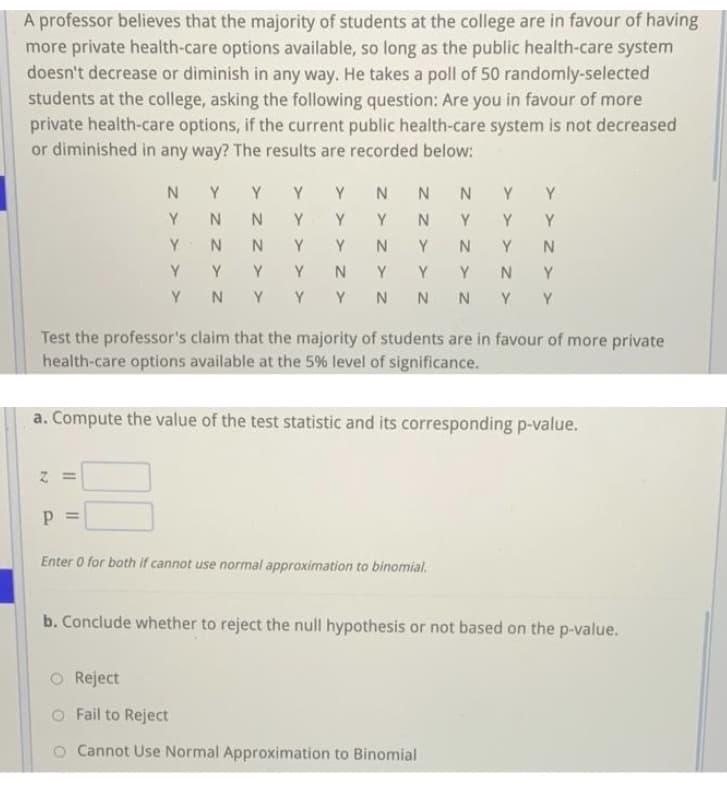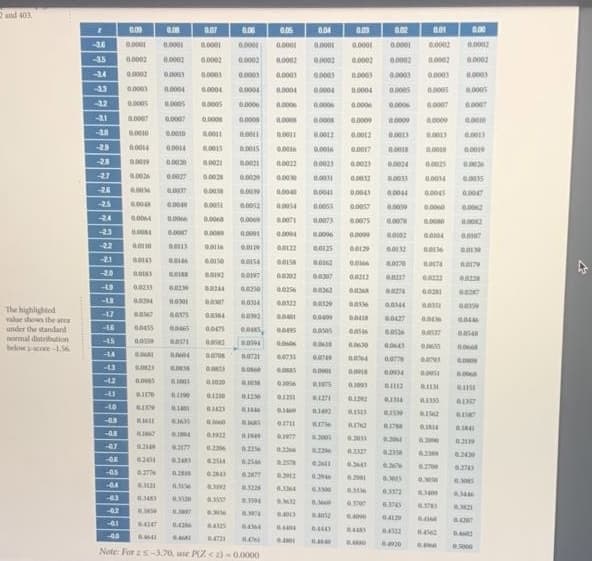A professor believes that the majority of students at the college are in favour of having more private health-care options available, so long as the public health-care system doesn't decrease or diminish in any way. He takes a poll of 50 randomly-selected students at the college, asking the following question: Are you in favour of more private health-care options, if the current public health-care system is not decreased or diminished in any way? The results are recorded below: Y Y Y Y N N Y Y Y Y Y Y N. Y. Y Y Y Y Y Y Y Y Y Y N Y Y Y Y Y NY Y Y N N NYY Test the professor's claim that the majority of students are in favour of more private health-care options available at the 5% level of significance. a. Compute the value of the test statistic and its corresponding p-value. Enter 0 for both if cannot use normal approximation to binomial. b. Conclude whether to reject the null hypothesis or not based on the p-value. O Reject O Fail to Reject o Cannot Use Normal Approximation to Binomial > >
A professor believes that the majority of students at the college are in favour of having more private health-care options available, so long as the public health-care system doesn't decrease or diminish in any way. He takes a poll of 50 randomly-selected students at the college, asking the following question: Are you in favour of more private health-care options, if the current public health-care system is not decreased or diminished in any way? The results are recorded below: Y Y Y Y N N Y Y Y Y Y Y N. Y. Y Y Y Y Y Y Y Y Y Y N Y Y Y Y Y NY Y Y N N NYY Test the professor's claim that the majority of students are in favour of more private health-care options available at the 5% level of significance. a. Compute the value of the test statistic and its corresponding p-value. Enter 0 for both if cannot use normal approximation to binomial. b. Conclude whether to reject the null hypothesis or not based on the p-value. O Reject O Fail to Reject o Cannot Use Normal Approximation to Binomial > >
Linear Algebra: A Modern Introduction
4th Edition
ISBN:9781285463247
Author:David Poole
Publisher:David Poole
Chapter2: Systems Of Linear Equations
Section2.4: Applications
Problem 28EQ
Related questions
Question

Transcribed Image Text:A professor believes that the majority of students at the college are in favour of having
more private health-care options available, so long as the public health-care system
doesn't decrease or diminish in any way. He takes a poll of 50 randomly-selected
students at the college, asking the following question: Are you in favour of more
private health-care options, if the current public health-care system is not decreased
or diminished in any way? The results are recorded below:
Y
Y
Y
Y
Y
Y
Y
N
Y
Y
Y
Y
Y
Y
Y
Y
Y
Y
Y
Y
Y
Y
Y
N
Y
Y
Y
Y
Y N
Y
Y Y N N NYY
Test the professor's claim that the majority of students are in favour of more private
health-care options available at the 5% level of significance.
a. Compute the value of the test statistic and its corresponding p-value.
Enter 0 for both if cannot use normal approximation to binomial.
b. Conclude whether to reject the null hypothesis or not based on the p-value.
O Reject
O Fail to Reject
o Cannot Use Normal Approximation to Binomial
I| ||

Transcribed Image Text:2 and 403.
000
0.07
000
8.000
0.000
.0001
0.000
0.000
0.000
0.0001
-35
0.0002
0.0002
0.0002
0.0002
0.0002
0.000
0.0002
0.0002
-14
0.0002
0.00
0.000
6.0003
0.000
.000
-13
0.000
0.0004
.0004
0.000
0.0001
0.000s
.000s
0.0005
12
0.000s
0.000s
0.000s
0.000
0.000
.0006
0.000
.000
-1
.0007
0.0007
0.000
0.000
.0000
0.0000
10
0.000
0.0011
0.0012
0.0012
.003
-29
0.0014
0.0014
.0015
.001
6.0018
0.00
0.00
-28
0.0030
0.0021
8.0022
0.002
0.0025
-27
0.0026
0.007
0.0028
0.0020
0.000
0.00
8.0013
0.004
-26
0.006
6.0037
0.00
0.000
0.0041
.0044
0.004S
0.00
25
0.00
0.00s
0.004
0.0055
0.000
-24
0.004
0.00
0.006
0.00
0.0071
.0075
-23
0.00
.0
0.000
0.00
0.004
0.0006
0.000
004
22
00122
0.0125
0.0129
-21
-2.0
0197
0.0233
0.0256
0.03
0.0
0294
The highlighted
valae shows the as
under the standand
normal distribution
belowse-1S
--17
0.0537
-15
0.030
14
0.077
0.0
0.0018
-42
0.1093
SISE
0.121
0.1
a1922
1977
-47
.220
.25
.2743
-as
2012
6.21
-63
0.343
-02
4013
BAS2
0.00
Note: For zs-3.70, use PZ <z)-0.0000
Expert Solution
This question has been solved!
Explore an expertly crafted, step-by-step solution for a thorough understanding of key concepts.
Step by step
Solved in 2 steps

Recommended textbooks for you

Linear Algebra: A Modern Introduction
Algebra
ISBN:
9781285463247
Author:
David Poole
Publisher:
Cengage Learning

Linear Algebra: A Modern Introduction
Algebra
ISBN:
9781285463247
Author:
David Poole
Publisher:
Cengage Learning